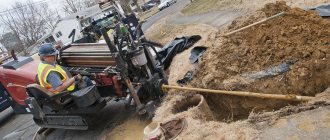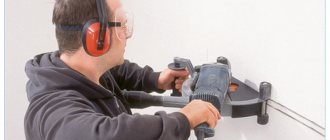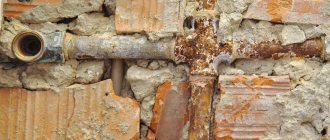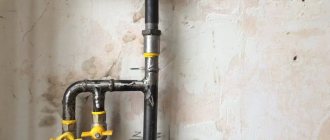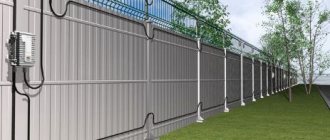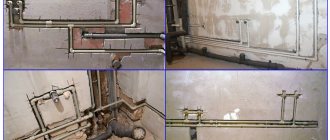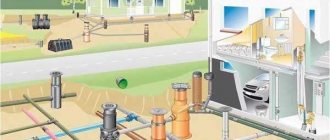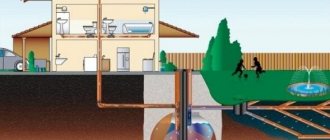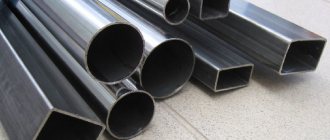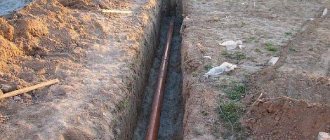When laying pipelines, pipes are usually laid in trenches to the designed depth. But in urban or cramped conditions, situations arise when a pipe line crosses water bodies, roads and railways, architectural structures, a unique landscape, and for technical reasons, trenchless pipe laying is required.
Several technologies have been developed for carrying out work in this area, using special equipment and qualified specialists. Each of the methods is designed for specific communications and overall dimensions of the line being laid and, despite complex and expensive equipment, brings an economic effect.
Rice. 1 Trenchless pipeline laying
Pipe insulation methods
Insulation for pipes
Thermal insulation of water pipes is necessary. This especially applies to the above-ground part of the pipe, located outdoors and in unheated rooms.
As insulation, you should choose a non-flammable and moisture-resistant material that will not swell when in contact with condensate. It must be resistant to environmental influences and temperature changes.
Thermal fiber and basalt wool are used from sheet materials. They retain heat well, but require an external waterproofing layer.
Convenient and inexpensive material - polystyrene foam. Cases made from it are sold in hardware stores. All that is required is to enclose the pipe in a heat-protective casing and seal it with several layers of tape. Heat insulators made specifically for pipes are convenient when working with corners and turns.
Expanded polystyrene is used for both external and internal work, and it is quite durable, which facilitates its reuse if it is necessary to dismantle the system.
If you place a water pipe inside another pipe, an air cushion is formed between their walls, which retains heat. But this is an additional measure; insulation will still be required.
If you follow all the rules for underground communications, you can independently install high-quality water supply that will last for many years.
What alternatives are there?
Gas supply to populated areas, gardening communities and enterprises can be carried out in different ways. The specificity of communications of this type is the need to protect them from mechanical influences and open flames.
To meet these requirements, the pipeline installation can be carried out in the following way:
- Trench. To lay the main line, a ditch 100-200 cm deep is opened. A cushion of gravel and sand is placed at the bottom of the pit. The pipes are protected from pressure during soil heaving with a layer of sand, which is poured along the edges and on top. After filling the trench, restoration measures are carried out. After a few months, subsidence of the soil above the route may occur.
- Airy. The pipeline is laid on steel supports or reinforced concrete blocks. Construction of the highway requires the use of heavy lifting and earth-moving equipment. The gas pipeline route requires regular clearing of grass, bushes and trees.
Both methods entail a temporary suspension of traffic on the road, disruption of its surface, fertile soil layer, and removal of plants and small architectural forms. The technologies are expensive and time consuming.
How to make a puncture yourself
Do-it-yourself soil piercing
The practical implementation of the method of trenchless pipe laying with your own hands is possible only over a relatively short area (no more than ten meters), and also if you are in good physical shape, which would allow you to perform heavy work operations. As for the equipment necessary for such work, you will definitely need the following simple tool:
- a simple welding machine;
- ordinary "grinder";
- small sledgehammer;
- reinforcement no thicker than 20 millimeters;
- steel pipe of your chosen diameter (several pieces);
- pump equipped with a plastic pipe;
- plastic barrel with a neck (capacity up to 200 liters);
- funnel with a hose up to 2 meters long.
The trenching process usually includes the following steps:
- Preparing a ditch on both sides of the route (with a margin of 12-13 cm). When digging it, the axis of the pipe that you plan to lay is outlined.
- After this, a pipe blank is taken and the end that is intended for driving into the ground is sharpened. In this case, it is best to cut teeth on it using a grinder.
- As you carry out all these operations (after each successive pushing of the pipe), you should wash out the soil from its hollow part.
- After each successive “rinsing” of the pipe, you should continue plugging it in with a sledgehammer.
Progress
The piercing process itself is a cyclic pressing - the jacks alternately switch to forward and reverse motion. The impact on the pipe is carried out through the head with clamps, cleaning rods or replaceable pressure pipes.
Using nozzles with a length of 1 to 4 m, completely pressing the pipe to the length of the rod stroke, it is returned to its original position and a double-length nozzle is placed in the resulting opening.
This process is repeated until the first section of pipeline is punctured (usually 6 m). After this, the next link is attached to it and the operation is repeated.
Puncture under the road
Puncture under the road is the most profitable, fast and expedient solution to your problem of laying communications, mainly pipes, without digging trenches! After all, to carry out work using this method, only 2 small pits are enough, and with the HDD method there is no need to dig holes at all! Thanks to our services, you have the opportunity to lay the communications you need, avoiding various obstacles along their route, the most common of which are roadways. Our work is carried out using professional compact equipment - soil puncture units with a controlled trajectory. This allows us to make punctures with high precision from small pits and from the basements of houses.
Our advantages:
- We lay sewer pipes with the required slope.
- We install pipes into an existing well.
- It is possible to bring equipment into the work area manually.
- The installation operates from a pit with dimensions of 1.8 x 2.3 meters.
Characteristics:
- The length of one puncture under the road is from 5 to 70 meters.
- Pipe diameter – from 32 to 315 mm.
- Types of pipelines - water, gravity sewer, pressure sewer, gas cases, cases for various cables (electric, telephone, fiber optic).
- Speed of work: from 20 to 100 meters per day.
Soil punching methods
For closed methods of laying pipelines (under a road, an architectural structure), in the absence of old lines, a protective casing is installed, inside which a working line of smaller dimensions is placed.
Steel, welded, seamless or spiral-welded pipes with a thickness depending on the laying technology are used as protective shells.
The pulling of protective casings is carried out using punching technologies, various puncture methods, horizontal drilling; in large cities, the shield method of underground excavation is used to place collector lines and tunnels.
Puncture
The technology used for puncturing is used when constructing wells with a diameter of up to 700 mm. in soils with high clay content. The essence of the method is to pierce the earthen rock with a pipe with a cone-shaped tip without removing it, after which the soil is compacted.
Punching pipes requires significant effort (up to 3000 kN); if the steel line is long, it cannot withstand the load, so the distance traveled is up to 80 m.
The main unit for carrying out this procedure is a hydraulic jack; work is carried out in the following sequence:
- The worker and receiving quarries are dug with dimensions determined by the depth of burial and the structural dimensions of the drilling frame with a jack, and the appropriate equipment is placed in them.
- Prepare pipes of a standard length of 6 m, covering them with waterproofing and installing a tip of the appropriate shape; for short distances, open-ended models are used. Jacks are used to mechanically press the pipe while changing the direction of travel; the force is transmitted through extension pipes, ramrods and clamps. During the piercing process, the pipes are replaced in increments of 1 m to a larger length by returning the jack rod to its initial state and increasing their size until the length of the recess reaches 6 meters.
- Weld the next pipe, installing the smallest size extension pipe, and repeat the procedure until the channel is completely passed through.
Hydropuncture
The use of water pressure is an effective way to penetrate earth rocks, widely used in drilling wells. When using this method, the passage pipe is equipped with a special nozzle into which water is supplied under pressure. Centrifugal electric pumps are used for pumping; dirt is pumped out of the pit using industrial slurry or drainage units.
The technology is effectively used in well-eroded sand rocks, it is characterized by simplicity and good speed of passage (30 m per shift), the disadvantages include the short total length of the shaft (40 meters for 200 mm and 20 m for 500 mm holes) and heavy working conditions for miners.
Vibration perforation
The use of vibration piercing techniques can speed up piercing work in sandy and quicksand rocks, and the technology is also widely used to remove old pipelines from mines. The penetration speed when using shock-vibration pressing units UVVGP-400 is up to 60 m per hour, the maximum length of the shaft is 60 m with a pipe diameter of up to 500 mm.
Rice. 4 Trenchless piercing installation
Punching
Punching pipelines with an open end and removing the earth plug is used in all types of rocks with a well length of up to 100 meters and a pipe circumference of 800 - 1720 mm. The piercing method is used for steel lines, sewers and tunnels made of reinforced concrete. When working, a pipe end equipped with a knife is squeezed into the ground, and the internal plug is developed and removed from the face.
For pressing, hydraulic jacks are used in various quantities, powered by high-pressure electric pumps, their force reaches 3000 kN, and the stroke of the rod lies in the range of 1.1 - 2.1 m.
If it is necessary to push through a hole of large diameter, powerful units of jacks are used, the ability to create forces of 10,000 kN.
To carry out piercing, a worker and a receiving quarry are dug, the length of which for large-circle products is up to 12 m, and the width is 5 m, the standard location depth is taken 0.2 m below the height of the passage channel.
In the receiving quarry, the ring knife is dismantled after excavation; this determines its working dimensions. Pushing work is carried out in several stages:
- In preparation, a working and receiving quarry of the required size is constructed, a support wall and guides are installed along which the pipes are moved, and power jacks are placed.
- The hydraulic pressing process is carried out using pipes that are periodically extended by the length of the rod stroke, and when the maximum recess is reached, the next pipe is welded and the process is repeated cyclically.
- When driving through reinforced concrete products or collectors, direct mechanical impact on their body is not allowed; the force is transferred to a pressure frame, which is placed between the passage pipe end and the nozzles that transmit energy.
- Excavation of soil inside the pipe is carried out using a mechanized method using a telescopic bucket (bailer, shuttle), which are placed inside the pipe channel and removed with ropes when filling. They are emptied through a special discharge window, after which they are again directed into the channel using pressure pipes. Sometimes, to remove soil, they use hydraulic washing and pumping out the sludge with pumps, crushing it with a hydraulic monitor and extracting it from the canal using an auger.
How to make a puncture yourself
Self-puncture of the soil
The practical implementation of the method of trenchless pipe laying with your own hands is possible only over a relatively short area (no more than ten meters), as well as if you are in good physical shape, which would allow you to perform heavy work operations. As for the equipment necessary for such work, you will definitely need the following simple tool:
- a simple welding machine;
- ordinary "grinder";
- small sledgehammer;
- reinforcement no thicker than 20 millimeters;
- steel pipe of your chosen diameter (several pieces);
- pump equipped with a plastic pipe;
- plastic barrel with a neck (capacity up to 200 liters);
- funnel with a hose up to 2 meters long.
The trenching process usually includes the following steps:
- Preparing a ditch on both sides of the route (with a margin of 12-13 cm). When digging it, the axis of the pipe that you plan to lay is outlined.
- After this, a pipe blank is taken and the end that is intended for driving into the ground is sharpened. In this case, it is best to cut teeth on it using a grinder.
- As you carry out all these operations (after each successive pushing of the pipe), you should wash out the soil from its hollow part.
- After each successive “rinsing” of the pipe, you should continue plugging it in with a sledgehammer.
Sanitation
The essence of the pipeline rehabilitation method is the trenchless replacement of old pipes with new ones.
There are two main types of rehabilitation.
Sanitation by relining
In this case, modern pipes made of high-molecular compounds (polymers) are pulled into an already equipped pipeline. This, in turn, can be done in two ways: without cutting the old pipes or with one.
In the first case, when the diameter of the new elements is slightly smaller than the original ones, it is necessary to inspect the inner surface of the pipes before starting work in order to prevent damage to the plastic pipes by obstacles located inside the old elements or complete inhibition of work.
The second option is used when it is necessary to lay pipes of large diameter, greater than or equal to the previous one. Then statistical hacking of the old design is used.
The work order is as follows:
- Along the edges of the area where work is planned to be carried out, recesses are dug (about 2x3 m in size).
- From the initial recess, retractable rods are drawn, at the working ends of which (in the same hole) a knife for expansion is fixed, which is fastened with a swivel to the pipe being laid from HDPE (low-density polyethylene).
- In the final pit, hydraulic jacks are installed on the frame, with the help of which the reciprocating movement of the installed rods is carried out. For additional reliability of the structure, the frame with jacks can be installed on a concrete slab.
- The drawing process begins, lasting until the moment when the knife comes completely into the final pit.
- Periodically, 1.5 m long rods are pulled out of the trench and cleaned of dirt.
As a result, the old pipes are cut with an appropriate knife, expanded, and a polymer pipe is inserted into them.
When carrying out relining, several recommendations must be taken into account:
- at the process design stage, the cross-section of the new HDPE pipe to be laid should be carefully selected;
- sections of new pipes measuring 10-12 m are welded on the surface and then carried into the system to be rehabilitated;
- the total length of the welded section should not exceed 0.7 km;
- When selecting the diameter of pipes and taking measurements, it is necessary to take into account the collar formed during welding, which in some cases reaches 15 mm.
Restoration of a pipeline using the relining method is allowed only in cases where a small change in the diameter of the pipeline is permissible or its throughput, due to the advantages of low-density polyethylene (smooth internal surface and low hydraulic resistance), increases.
Renovation
This option is accompanied by the complete destruction of old structures with the simultaneous laying of new pipes. This method is used when the old pipeline either cannot meet the increased capacity requirements or is too dilapidated. Using the renovation method, it is possible to lay pipes of both larger and smaller cross-sections than the original ones.
This method also exists in two versions: replacing old pipes with new HDPE pipes with threads, or destroying the pipeline.
In the first case, it is possible to replace a specific damaged section of the pipeline. The faulty section of pipe is cut with roller knives, the tunnel is enlarged using an expander, and then new pipes are inserted.
In the second option, the pipeline, as with relining, breaks in a static way.
Advantages of rehabilitation:
- no need to dig new tunnels - you can use already equipped communication systems;
- it is almost impossible to damage other pipelines during work;
- you can change the diameter of old pipes to meet modern requirements;
- the costs of carrying out land and restoration work are minimal.
Trenchless installation methods
Trenchless installation of a sewerage system is usually carried out in the following ways:
- Road puncture - used when working with pipes with a diameter of 100 to 400 mm.
- Horizontal directional drilling - used for pipes with a diameter from 110 millimeters to 800 millimeters.
- Punching with steel cases is carried out for pipes 159-1420 millimeters.
For laying sewer systems using the puncture method, small-sized equipment is used, which allows work to be carried out in small pits.
All types of Vermeer brand HDD equipment are described here. And here you can familiarize yourself with the characteristics of equipment from other well-known brands.
All preparatory work takes a minimum of time, despite the fact that the maximum penetration rate is achieved in the work process. Such pipe laying can be implemented in the shortest possible time. However, there is one caveat - the length of the penetration cannot exceed fifteen meters.
The HDD method is ideal for laying long-distance sewer lines.
Sinking using a horizontal directional motion installation includes three working phases. First of all, a pilot well is installed, then the well is expanded to the required diameter and at the third stage the pipeline is pulled.
The laying of sewer pipes in a steel case is indicated when communications pass under highways or railway lines. The steel case serves as a protective casing. Most often, this technology is used in the construction of gravity sewers, which are characterized by straight lines and angles of inclination in unreliable floating soils.
HDD horizontal directional drilling method
There are two types of drilling:
- Separate. With this method, a shaft is first formed with drills, and after removing the tool, a line is drawn.
- Combined. With this type, drilling is carried out together with pipes that are moved along the channel.
Horizontal drilling units (UB, UGB) allow passage with line laying at a speed of up to 19 m per hour with a shaft length of up to 60 m, the range of drilled hole sizes is 325 - 1420 mm, more productive units of this type are capable of laying a line up to 120 m.
Drilling is carried out using knife attachments with rock removal using a screw conveyor; for larger sizes, a small-diameter pilot hole is used. After drilling it, a special expander is installed on the auger and the drilling rig is switched to reverse mode.
Fig.6 Passage using a special tunneling shield (microtunnelling)
Although the forces used during drilling are lower than when piercing, significant disadvantages of the method include the need to transport soil from the drilled well. New laying technologies make it possible to avoid this drawback - the shaft is cut through with propeller-type knives with further rolling of the rock in the annulus.
An effective method for making horizontal shafts is the use of self-propelled pneumatic machines (Mole), which form a channel with dense walls 63 - 400 mm wide. and up to 50 m long.
The device is a self-propelled pneumatic machine of the impact principle with a hammer that carries out translational and return vibrations under the influence of compressed air. Maintaining the accuracy of a given direction is determined by the significant length of the body; the reverse movement is resisted by friction against the earthen walls.
Rice. 7 Directional auger drilling method
Conduct research on the soil you are going to pierce
Self-punctures are performed without specialized equipment that can penetrate sand and clay through rock. Make sure that after going halfway you won't come across any unexpected rock formation. It is worth examining the soil so that your puncture does not collapse or sag over time. In order to study the soil, you need to contact specialists who carry out geophysical and geodetic work. As a rule, companies engaged in horizontal directional drilling have such specialists on their staff. You can also contact companies specializing in land management work. Geophysical research will allow:
- determine the composition and some properties of the soil
- identify specific soil
- identify hazards at the construction site
- find underground voids
- determine the level, speed and direction of groundwater filtration flow
All this will allow you to protect the tool from damage, and ensure the reliability and durability of your construction work.
Features of trenchless pipe laying
For many years, laying the pipeline in a trench has remained a common method for installing urban communications. The consequences of these works are dug up sidewalks and green areas, damaged road surfaces, changed public transport routes and constant indignation among citizens. Although this whole nightmare can be avoided if you use trenchless pipe laying technologies.
This is a closed method of installing and repairing utility lines, in which underground work is carried out without opening the soil. In this case, there is no need to build additional crossings, change traffic routes, or carry out a large number of coordination with other public utilities.
When laying trenchless pipelines, 90% of the work is done underground.
Compared to laying a sewer pipe in a trench, the trenchless method involves installing utility networks using horizontal directional drilling, pushing pipes, puncturing the soil, and sanitation. This is the most promising way to build new and repair or replace old water supply and sewer networks in a large city.
Advantages of the method
The main advantages of the method are clear even to the average person who cares about the appearance of his hometown.
- All communications that pass near the pipeline remain unharmed. After all, when digging a trench, breaks in neighboring networks very often occur.
- The economic benefit is that there is no need to connect additional equipment and labor for excavation work and backfilling of the pipeline trench.
- There is no need to carry out subsequent repairs of damaged asphalt and paving slabs.
- Speed of work.
- Possibility to carry out work in winter.
- Preservation of the landscape, road surface, green areas.
- Minimal harm to the environment.
- There are almost no emergency situations.
The advantage of using the trenchless method is that special preparatory excavation work is not required. For example, laying polyethylene pipes in a trench involves using an excavator and placing a bed of sand or gravel at the bottom. After installation, backfilling of the pipeline trench follows (SNiP imposes special requirements for this stage of excavation work), compaction and compaction of the soil. And in the case of a closed method of laying pipes, all that is required is a well-designed work project, a thought-out optimal route without bends and turns, a calculated depth and slope of the pipeline.
Scope of use
The trenchless method of laying pipes is universal because it can be used for various types of communications. You cannot do without it when constructing pipelines under a busy highway, railway track, metro lines, river, as well as in conditions of dense other networks. This could be the following communications:
- water pipes,
- sewerage,
- electrical cables,
- pipeline,
- gas pipeline,
- communication cables.
Special equipment
To carry out such work, special equipment is required. Depending on which method of trenchless pipe laying is used for a particular utility line,
- drilling rigs,
- hydraulic,
- location installations,
- generators,
- welding machines for plastic pipes,
- mortar-mixing units,
- automanipulators.
The soil is pressed using a powerful hydraulic unit.
Types of punctures
The puncture method is used when laying water pipes under the road.
Depending on the mechanisms used and the principle of laying a channel for laying pipes, the following types of puncture are distinguished:
- pushing;
- horizontal directional drilling (HDD);
- auger drilling;
- hydropuncture;
- vibration puncture
Punching
This type of puncture is performed as follows:
- A directional drilling unit is placed in the initial pit, consisting of a frame with hydraulic cylinders that drive a carriage with a drill string - interconnected rods.
- The first to be installed in the carriage is a rod with a working head in the form of a sharp cone.
- Using an oil station (a gasoline engine with oil pumps), hydraulic cylinders forcefully press the first rod into the wall of the pit.
- After most of the first rod has disappeared into the soil, the carriage is pulled back using hydraulic cylinders. Using a threaded connection, screw the next one to the end of the rod, secure it in the carriage and repeat the pushing process.
- When the working head of the first rod of the drill string appears in the final pit, it is removed and a device for fastening and pulling the pipe is installed.
- By pulling out the pipe attached to the first rod, it is laid in the channel (case) drilled in this way.
Horizontal directional drilling
This method is widely used when laying water supply networks with a diameter of up to 200 mm. The puncture is carried out by special self-propelled units on caterpillar tracks, capable of working in conditions of limited space and marshy soil.
The technology for performing horizontal directional drilling consists of the following stages:
- Drilling a pilot well - in this case, the installation deepens a string of rods with a working drilling head in the form of a blade on the first of them at a given angle and punches a narrow channel, reaching the surface or in the wall of the final pit at the end point of the pipeline laying trajectory.
- Sequential expansion of the pilot well - at this stage, the working head is replaced with a special rotating expander (rimmer), which, when pulling the rod string, increases the diameter of the channel to the required value. At the same time, new drill rods are attached to the end of the rimmer - this is necessary so that after expanding the channel, it is possible to conveniently and quickly pull a string of pipes through it.
- Pipeline pulling - a swivel (earring) is installed on the last rod connected to the rimmer, to which the head of the pipe string is attached. The pipeline is pulled by removing the rods using the installation until the end of the pipe appears at the starting point of drilling.
During the work process, a special composition is supplied inside the drill string rods and to the tip (working head), which helps to destroy the rock being drilled, reduce the friction of the rods on the soil, and remove the drilled rock from the well. After completion of the work, the drilling mixture collected in the pit is pumped out, cleaned of rock particles and regenerated with the help of chemical reagents for subsequent use.
Auger drilling
This method of trenchless laying of water supply and other communications is as follows:
- An auger rotating from the installation engine with a working head (blades) in the end part is installed inside the large pipe-case.
- When the pipe is pressed into the wall of the pit, the rotating auger drills through the rock encountered in its path and partially removes it through the end of the pipe.
- After the first pipe has completely disappeared into the soil, the next one with the same auger inside is connected to it;
- When the end of the pipe string appears in the final pit, all the augers are sequentially removed from it with the remains of the drilled rock that was not removed by them.
Several water supply lines are placed into a pipe drilled in this way.
Hydropuncture
This type of puncture is performed using a horizontal drilling installation, in which a special head is placed at the end of the first rod of the drill string, piercing the soil layer in front of it using a powerful jet of water created by a centrifugal pump.
This method is used to puncture loose sandy and sandy loam soils.
Vibration puncture
During vibration puncture, the working body of the pneumatic punch, in addition to rotational movements, also performs powerful reciprocating movements (like a jackhammer). Thanks to this, such installations can quickly and efficiently pierce even the densest clay or loamy soil.
Advantages of the method
The popularity and demand for this method of laying water pipes is explained by the following advantages:
- Efficiency of work - compared to digging an open trench, puncturing takes 3-4 times less time.
- Low labor intensity - puncturing does not require significant physical effort and a large number of workers, as is the case with the trench method of laying pipes.
- All-season use - piercing the soil for water supply can be done at any time of the year using various installations.
- Environmentally friendly - this method of laying a pipeline avoids disturbance of the soil structure, damage to tree roots, destruction of natural landscapes, artificial lawns and plantings.
- Low risk of damage to nearby communications (sewerage, communication lines, gas pipelines) - when a puncture occurs, the likelihood of damaging nearby communications is much less than when excavating soil with an excavator or trencher.
- Low cost - even when hiring specialists with special equipment, digging a sewer using the puncture method costs 30-40% less than traditional trenching.
Benefits of technology
Trenchless technologies, unlike other methods of conducting utility networks, have a number of advantages. Among them:
- Low cost. If there is a puncture after completing the work, there is no need to restore the asphalt surface or dig a trench.
- Minimal risk of damage to previously laid communications.
- Small time investment.
- Possibility of communications in densely built-up areas.
- Minimum amount of labor.
In addition, thanks to the trenchless method of conducting communications, the environment is not harmed. When laying utility networks, it is not necessary to disturb the top layer of soil and green spaces.
Horizontal directional drilling saves money and time. Unlike the trench method of conducting communications, there is no need to dig a trench, which reduces the work time. When puncturing the soil, there is no need to violate the integrity of the asphalt pavement, underground and surface communications.
Horizontal directional drilling does not require stopping the movement of vehicles and the operation of other communications.
The HDD method also reduces time, since there is no need to dig a trench. The speed of operation is twice as fast. The cost of work when puncturing the soil, in contrast to other methods, is 30-50% lower. This is due to the fact that digging trenches requires time and money, and also does not require transportation and disposal of soil.
Performing soil piercing when working with private customers requires the use of small diameter pipes. The length of the pipeline is from 50 meters.
Directional drilling, HDD technology
Our company is a leader in the construction of pipeline laying using horizontal directional drilling. We cooperate with reliable suppliers. Our highly qualified specialists perform the work quickly and efficiently.
The first thing that needs to be done is to agree on the construction or reconstruction project
It is not worth performing a puncture under the road without a plan and approval, primarily for two reasons. The first reason is personal safety. It may turn out that certain types of communications already pass under your site that you did not know about. There were rare cases when hidden pre-war communications were not known even after the project had been agreed upon. It is still worth taking precautions so as not to puncture the gas pipe adjacent to your site - the consequences can be disastrous.
The second reason why it is better to get approval is a fine from city authorities for uncoordinated actions. This is especially true for those types of communications that go beyond the boundaries of your personal area: cases when you need to enter a common main pipe, etc.
What should be done before laying the pipeline?
Development of the project and its approval is the first stage that the owners must complete. Any construction project must have a detailed, accurate plan for laying communications.
Getting approval
Preliminary coordination with local administration authorities will avoid all problems in the future:
- other communications may pass under the road, and acting at random can easily damage them;
- the initiative is punishable: the master is unlikely to like a serious fine for unauthorized drilling.
An “amateur” connection to the highway without project approval can lead to the same result.
Soil research
If you plan to contact specialists, then such surveys are usually carried out by representatives of a company specializing in pipeline laying. Another option is to invite employees of an organization conducting geodetic work. As a result, the master will know:
- type, composition of soil;
- about the presence/absence of voids, solid inclusions;
- depth of groundwater, direction, speed of its passage;
- potentially dangerous “areas on the site”.
All this knowledge will not be superfluous in any case. If we talk only about laying a pipeline, then awareness of the characteristics of the soil will give a 100% chance of avoiding the collapse of a “freshly made” tunnel.
Differences from other trenchless installation methods
Horizontal directional drilling is similar to a number of other methods of laying pipes using the trenchless method - auger drilling, microtunneling, controlled puncture. The fundamental difference is in flushing the well with bentonite drilling fluid.
The solution performs the following tasks:
- During the drilling or expansion process, it exits through the nozzles at high speed, creating a cutting effect.
- Reduces drill friction and soil sticking to the head, cools the tool
- Strengthens the walls of the well and protects them from destruction
- Facilitates the passage of the pipe into the drilled hole
- Brings crushed rock outside
The composition of the drilling fluid is one of the key factors for the success of the operation and is selected according to the type of soil.
Let's consider the classification of the main methods.
A group of uncontrolled methods. Drilling can be carried out:
Tunneling machines performing haulage:
- flushing;
- screw;
- with suction.
Flushing drilling.
Occurs by washing with bentonite. The probe is controlled.
Pilot drilling followed by:
- dry or wet expansions;
- expansion in rocky soil.
Let's briefly look at the key principles and points of laying pipes using trenchless methods.
Auger drilling (or auger drilling) is widely used in industry and construction. This is especially true in cramped conditions. The case is pressed simultaneously, removing excess rock. The possibility of collapses is also prevented.
The advantages include the integrity of the soil surface and the environment, operability in various rocks and in any weather, the creation of a channel of the required length and diameter, and there is no soil subsidence.
The simplest drilling rigs will do. Their basis is a drill head with augers located lengthwise behind it. Motors can be electric, hydraulic or pneumatic.
The price of HDD of this type allows you to minimize costs. The estimate includes a calculation of each stage and takes into account the conditions.
Pilot drilling. They resort to it in cases of laying routes and routes for pipelines for industrial purposes. In installations for this type of operation, the drill heads are beveled. Can be equipped with special nozzles for supplying bentonite. A special sensor located in the head part determines the trajectory of movement.
Any trenchless pipe laying has a number of its own special, undeniable advantages that set it apart from others:
- versatility for any type of task: from pipelines in desert areas to densely built-up urban areas;
- high-precision technologies guarantee the accuracy of laying any type of communications;
- the length of the tracks is up to hundreds of kilometers, the diameter is from 12 m and above;
- Heavy equipment and many workers are not needed, therefore, labor costs are minimized. One installation and no more than four workers is all that is needed;
- HDD pricing policy allows you to save up to 50% of finances and terms up to 20 times;
- the possibility of damaging nearby networks is minimized;
- At the same time, the walls of the shaft are laid and strengthened. This is facilitated by special solutions in combination with soil compaction;
- mountains, rivers, foundations of houses, etc. - no problem;
- no dependence on weather conditions;
- environmental friendliness: the top layers of the soil are absolutely not damaged.
It is better to entrust such an important and responsible task to highly professional specialists, since a number of conditions must be met: the presence of special installations, trained employees with appropriate qualifications. Also knowledge of regulatory documents, conducting geological exploration studies. We have everything necessary from the above list, most importantly, vast experience in this industry, we undertake the coordination of all technical documentation
And this is the best guarantee of quality and durable, uninterrupted operation.
We have everything necessary from the above list, most importantly, vast experience in this industry, we undertake the coordination of all technical documentation. And this is the best guarantee of quality and durable, uninterrupted operation.
HDD price. As for payment for work, in each specific case the estimate is drawn up taking into account the specifics of your order, and the price is determined individually. The final score is influenced by the type of soil, the required length of the mine, and materials.
Our experts and the wide range of unique technologies for trenchless pipe laying will solve all your difficulties and eliminate unnecessary headaches in the shortest possible time. And during this time you will live at your usual rhythm.
Modern construction companies engaged in laying pipelines and other communications are gradually minimizing the use of the trench method, which is losing its relevance, preferring new, time-tested, unique developments. Thanks to new technologies, today it is possible to carry out complex construction work without causing harm to surrounding objects, without large financial investments.
Conditions of conduct according to regulatory documents
The laying of any pipeline, be it polypropylene or steel, is determined by standards. It is SNiP that regulates many technical issues that allow all work to be completed efficiently, ensuring safety. To lay polypropylene pipes, the following requirements must be met:
Diagram of the advantages of polypropylene pipes over other materials
- It is imperative to take into account the freezing point of the soil. Usually it is at a level of 1.4 meters, so if the pipeline is at a lower level, then in winter the water in it will simply freeze and it will be impossible to use the pipe. Therefore, during installation it is necessary to accurately calculate such moments; in the future this will only be beneficial.
- The laying of pipes largely depends on what buildings are located on the site, whether there are nearby roads and highways, communication and other utility networks. If you are not sure where exactly the pipeline can be laid, it is better to contact specialized construction companies.
- When laying underground, we also take into account the characteristics of the relief and soil; in some cases it is necessary to protect the pipe with the help of special casings.
The polypropylene pipeline is laid subject to the following steps:
- First you will have to prepare a trench for laying, which should be larger than the diameter of the pipe. So, for 110 mm pipes you will need a trench with a width of 600 mm. The minimum distance between the pipe wall and the trench should be 20 cm. The burial depth should be 50 cm greater.
- The bottom is sprinkled with sand with a cushion thickness of approximately 50-100 mm, after which the sand is compacted.
- The laying starts from the building; when installing sewer pipes, the socket should face the end of the pipe going outside;
- A special lubricant is used to connect individual elements.
- When laying sewerage, you must remember that a slope of 2 cm must be maintained for every meter of the route.
- After installation, the pipeline is covered with sand and compacted only from the sides. If necessary, before this the pipe is wrapped with a heat-insulating layer;
- At the very end, polypropylene pipes are connected to a common highway, treatment plant, etc. This must be done using polypropylene solder.
What problems may arise during installation?
When laying polypropylene pipes underground, some problems may arise:
- the structure of the soil does not allow digging to the required depth;
- in winter, the soil freezes strongly, which can cause damage to pipes;
- There is a building on the site that is not possible to get around.
In this case, there are several ways to solve these problems:
- If the soil is too loose or hard, it is recommended to make a puncture, in which a steel pipe is first laid, and a polypropylene pipeline is inserted into its cavity.
- When the ground freezes, it is recommended to lay a heating cable along the entire route. This requires significant costs, and expenses in winter may exceed those planned, but in any case, this option is cheaper than constantly repairing burst pipes.
- If there is any structure or object along the route that cannot be damaged, it is recommended to use trenchless construction methods, that is, puncture. In this case, you can not only lay the pipeline, but also protect it with a steel casing. When laying such networks, it is necessary to carefully look at the layout of communications on the site so as not to damage existing ones.
Specifics of laying sewerage using the HDD method
The construction of a pilot sewerage pipeline is carried out strictly in accordance with the design documentation and under the supervision of an experienced professional. At this stage, it is necessary to monitor the slope of the drill and its trajectory. In case of small errors, the drill's departure is corrected, and after pilot drilling is completed, the channel is widened and the pipes are pulled.
At the final stage of HDD, the gravity sewer has a somewhat horizontally curved appearance and is not completely visible to light. However, even taking this factor into account, trenchless installation has excellent results, minimal errors and risks of emergency situations. As a rule, a gravity sewer network is laid at a depth of 3.5-4.5 m, and this method is used even in sandy or watery soils where digging trenches is not possible.
Laying sewerage using the HDD method is considered the optimal method due to various factors. Our professionals will ensure the development of qualified design documentation and implement it using modern drilling equipment. We have successful experience in laying gravity networks, and will provide installation even in the most difficult soils.
Prices for gravity sewerage using the HDD method
| Diameter of the pipe being laid | Cost of laying 1 meter of pipe including VAT |
| 63 mm | 800 - 1,800 rub. |
| 110 mm | 1,000 - 2,500 rub. |
| 160 mm | 1,800 - 4,000 rub. |
| 225 mm | 2,500 - 6,000 rub. |
| 315 mm | 3,500 - 7,000 rub. |
| 400 mm | 5,000 - 10,000 rub. |
| 500 mm | 6,000 - 12,000 rub. |
| 630 mm | 8,000 - 16,000 rub. |
| 710 mm | 12,000 - 20,000 rub. |
| 800 mm | 15,000 - 23,000 rub. |
ATTENTION! The cost of HDD work does not include: the cost of pipes, preparation of the starting and receiving pits, as well as excavation of communications at the site.
Price calculator
Leave a request for an estimate. For free!
What tools will you need?
You can do a puncture under the road yourself. Before starting work, you must prepare the following set of materials and tools:
- apparatus for performing welding work and a grinder;
- sledgehammer;
- steel reinforcement or rods, the diameter of which must be 25 millimeters or more, and the length must exceed the width of the road by ten centimeters;
- cuttings of steel pipe of the required diameter and the same length as the rods;
- pump with a plastic tube with a diameter of 12 millimeters;
- a barrel designed for two hundred liters;
- funnel with a two-meter hose.
In addition to tools, you will need remarkable physical strength and patience.
Choose the appropriate communication method
There are several methods that allow you to lay underground communications: direct puncture, the punching method, tunneling using shields and horizontal directional drilling, etc. The choice of method depends on:
- length of necessary communication,
- puncture diameter,
- nature of the soil (presence of rocks, natural groundwater)
- the nature of the development on your site
- the presence of existing underground communications
- your construction budget
Comparative table of methods for trenchless laying of communications
Please note that the choice of a trenchless pipe laying method depends on the diameter and length of the pipeline, physical and mechanical properties and hydrogeological conditions of the soil being developed and the equipment used. It may be advisable to use a different installation option in your area.
Special equipment
Trenchless installation of water pipelines involves the use of special equipment and machines. Without it, it is impossible to drill a hole, for example, under a highway (except for external digging).
Thanks to the use of special equipment, work can be carried out at any time of the year with any type of soil.
Use cases and types of equipment:
- Pumping and jacking unit - allows you to make a well, bypassing all obstacles. The kit should include a hydraulic station, expander, rods and cutting heads.
- A hydraulic station is a device that provides force using a hydraulic cylinder. Average capacity – 36 tons.
- When performing hydropunctures, special devices are used that shoot a powerful, directed stream of water. Used on sandy soils. Using such equipment, it is possible to lay pipes with a diameter of up to 50 cm. The length of the pipeline is limited to 30 m.
- Vibrating equipment operates on the principle of pushing. The installations used in this method have a shock-vibration-pressing operating principle. In this case, the diameter of the pipes is the same as with hydraulic punctures. But the length of the well doubles (60m).
- Additional equipment is also used. These can be machines with manipulators, welding, generators, mortar-mixing units.
Possible difficulties and problems during installation
Before digging a trench, find the underlying communication networks on the technical documentation drawings of the land plot: gas pipeline, telephone, heating, electrical cables. If there is no such documentation, please contact the administration. They have equipment at their disposal that can find an existing utility network at any depth. This will allow you to avoid damaging another network during the process of digging a trench for the water supply.
If the water supply is from a well on the site, no permitting documents are required. But if you are connecting to an existing network or laying a pipe through a neighbor's property, you will need official permission from the local authorities in writing. Otherwise, you may create an emergency situation, which could lead to legal action. It is necessary to agree with neighbors in advance and obtain approval for excavation work.
The problem may be the soil: hard, soft, waterlogged, rocky or unstable. Laying a water pipeline in such conditions will be more expensive, since additional protection and fastening of the entire system will be required.
Pros and cons of trench laying
To understand why trenchless installation of sewerage and other engineering systems is now actively used to overcome various obstacles, we need to dwell briefly on traditional technology.
Advantages of trenches
Tradition is the main advantage. In this case, I was attracted by the simplicity of the work and the undemanding nature of the performers, if you do not mean physical strength. But in most cases it is not important. The reason is the ability to transfer most of the work to available equipment, because hiring an excavator or bulldozer is usually not difficult. This is where the list of advantages ends.
Disadvantages of the usual method
There are more of them. The disadvantages include:
- the need to stop traffic in the area chosen for work;
- serious temporary losses due to the dismantling of the coating and then its restoration;
- death of plants due to damage to the root system, destruction of the fertile soil layer.
However, the main disadvantage of trench technology is the inability to bypass serious obstacles - bodies of water, wide busy highways or railway tracks. For this reason, trenchless methods have no alternatives.
